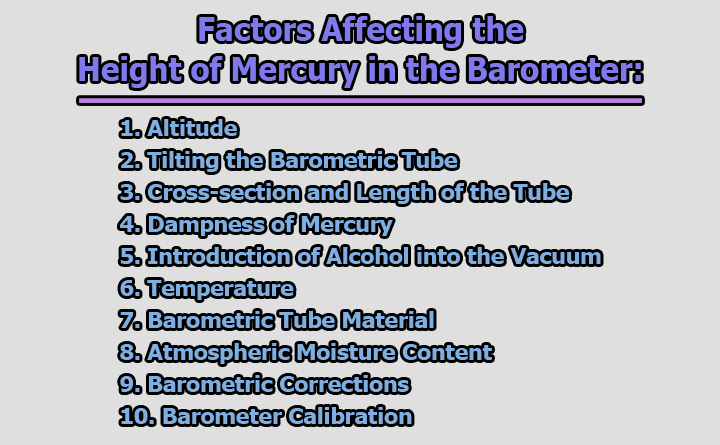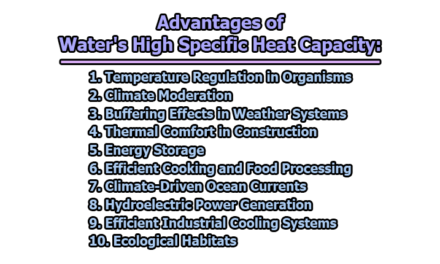Factors Affecting the Height of Mercury in the Barometer:
Barometers, instrumental in measuring atmospheric pressure, play a crucial role in weather forecasting and scientific research. The height of mercury in a barometer is affected by various factors, each contributing to the accuracy and reliability of pressure measurements. In this article, we will delve into the key factors affecting the height of mercury in the barometer and understand the intricacies involved in these measurements.
1. Altitude: Altitude plays a pivotal role in influencing the height of mercury in a barometer. As one ascends to higher altitudes, the density of the air diminishes, leading to a decrease in atmospheric pressure. This relationship is fundamental to the barometric measurement, as pressure is directly proportional to the weight of the air column above a specific point. For every 110 meters of ascent, the mercury level in the barometer falls by approximately 1 cm.
The rationale behind this phenomenon lies in the reduced weight of the air column above the barometer as altitude increases. With lower atmospheric pressure at higher altitudes, the mercury in the barometer experiences less resistance and, consequently, occupies a lower position in the tube. This consistent correlation between altitude and mercury height is a key consideration in accurate pressure readings and is vital in various scientific applications.
2. Tilting the Barometric Tube: Maintaining the barometer tube in a strictly vertical position is imperative for precise measurements. If the tube is tilted, it can lead to misleading results. In such cases, while the mercury may occupy a longer length within the tube due to the tilt, the vertical height (h) remains unchanged, as the atmospheric pressure hasn’t altered.
However, if the tube is tilted in a way that the vertical height falls below a certain level (h cm), it signifies that air has entered the tube. This introduction of air acts as a cushion, preventing the mercury from filling the tube properly. A correctly functioning barometer should promptly be filled with mercury in such instances, ensuring the absence of any anomalies in the measurements.
3. Cross-section and Length of the Tube: The cross-sectional area or shape of the barometer tube doesn’t impact the vertical height of mercury, given that atmospheric pressure remains constant. Regardless of the tube’s geometry, the pressure exerted on the mercury is consistent, maintaining the equilibrium in the barometric measurement.
However, if the tube is immersed in a trough or container of mercury, the length of the vacuum within the tube decreases. This reduction is attributed to the atmospheric pressure pushing mercury into the tube. In the event that the vertical height falls below atmospheric pressure (h cm), a metallic click should be heard, signaling that the tube needs to be filled with mercury. Failure to address this issue could result in inaccurate readings and render the barometer faulty.
4. Dampness of Mercury: The dampness or presence of moisture in the mercury used within the barometer is another critical factor affecting its accuracy. If the mercury is damp, even a small amount of water can evaporate into the vacuum within the tube. This water vapor exerts additional pressure on the mercury column, causing fluctuations in its height. In practical terms, the mercury level might rise or fall inconsistently, leading to unreliable readings.
To maintain precision in barometric measurements, it is essential to ensure that the mercury used is completely dry and free from any moisture. This precaution helps prevent the introduction of extraneous variables that could compromise the integrity of atmospheric pressure readings.
5. Introduction of Alcohol into the Vacuum: The intentional introduction of alcohol into the vacuum above the mercury column can also influence the height of the mercury in the barometer. As the alcohol evaporates, its vapor exerts pressure on the mercury, causing the mercury level to fall. After a certain period, the alcohol vapor becomes saturated, ceasing further evaporation. At this point, the mercury surface stabilizes, reflecting the equilibrium between the alcohol vapor pressure and atmospheric pressure.
Understanding this dynamic is crucial, especially in experiments where alcohol might be introduced deliberately for specific purposes. It highlights the transient nature of such changes and the importance of allowing time for the system to reach equilibrium before relying on the barometer readings.
6. Temperature: Temperature variations in the surrounding environment also impact the height of the mercury in a barometer. During the hot season, the mercury level tends to fall. This phenomenon can be explained by the fact that hot air is less dense and tends to rise. As hot air ascends, the atmospheric pressure at ground level decreases, causing a corresponding drop in the mercury column within the barometer.
This relationship between temperature and barometric measurements underscores the need for considering seasonal variations when interpreting atmospheric pressure data. Meteorologists account for these temperature-related changes to ensure accurate and reliable weather predictions.
7. Barometric Tube Material: The material of the barometric tube can influence the height of mercury. Different materials have varying coefficients of thermal expansion, meaning they expand or contract differently with changes in temperature. If the tube material expands or contracts significantly with temperature fluctuations, it can impact the internal volume of the tube, affecting the height of the mercury column. This factor emphasizes the importance of using materials with minimal thermal expansion for precise barometric measurements.
8. Atmospheric Moisture Content: Beyond the moisture content within the mercury, the general atmospheric moisture can also impact barometric readings. High humidity levels can potentially lead to the condensation of water vapor within the barometer tube, affecting the vacuum and introducing errors in measurements. To mitigate this, barometers are often housed in controlled environments to minimize the impact of external atmospheric conditions on the instrument.
9. Barometric Corrections: Barometric corrections are necessary to account for non-standard conditions. Standard atmospheric pressure is defined at sea level under specific temperature and humidity conditions. However, in real-world scenarios, these conditions vary. Barometric corrections involve adjusting the observed barometric pressure to a standard reference point, compensating for altitude, temperature, and humidity differences. This ensures that barometric measurements are comparable and consistent across different locations and conditions.
10. Barometer Calibration: Regular calibration of barometers is essential to maintain accuracy. Over time, wear and tear, as well as changes in the instrument’s internal components, can lead to deviations in measurements. Calibration involves comparing the barometer readings to a reference standard and making necessary adjustments to ensure accurate and reliable results. Calibration intervals depend on the instrument’s usage and environmental conditions.
In conclusion, understanding the factors that influence the height of mercury in a barometer is essential for obtaining accurate atmospheric pressure measurements. Altitude, tube positioning, tube characteristics, moisture content, alcohol introduction, and temperature fluctuations all contribute to the delicate balance required for precise barometric readings. Scientists and meteorologists rely on this understanding to interpret weather patterns and make informed predictions, showcasing the significance of these factors in the realm of atmospheric science.

Assistant Teacher at Zinzira Pir Mohammad Pilot School and College










